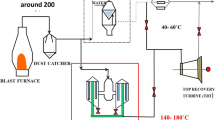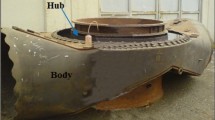Abstract
The present study was conducted to investigate the root cause failure analysis of 316L stainless steel air tube inlets at the weld joint in a High-Speed Power turbine (HSPT). Fractography analysis revealed ratchet marks and striations on the fracture surfaces, indictive of vibration-induced fatigue in the heat affected zone of the tube-to-flange weld joint, resulting from the rotation of the HSPT at high speed, identified as the primary cause of failure. Additionally, radiography and visual inspection unveiled a sharp interface between the weld metal and parent metal within the inner wall, acting as a stress riser. X-ray diffraction analysis demonstrated that the parent metal predominantly consisted of austenite (γ), while the weld metal comprised a mix of austenite (γ, ≈ 90%) and delta ferrite (δ, ≈ %10). Hardness readings in the weld zone ranged from 260–302 HV, compared to ≈ 140 HV in the parent metal. Microstructural examination showed inclusions and impurities rich in manganese, and silicon, likely introduced during manufacturing and/or welding processes. Conclusively, the study attributes failure to the use of low-quality materials and consumables, poor welding practices, and insufficient vibration condition monitoring.















Similar content being viewed by others
References
T.S. Chowdhury et al., A critical review on gas turbine cooling performance and failure analysis of turbine blades. Int. J. Thermofluids. 18, 100329 (2023)
A.T. Fahmi, K.R. Kashyzadeh, S. Ghorbani, A comprehensive review on mechanical failures cause vibration in the gas turbine of combined cycle power plants. Eng. Fail. Anal. 134, 106094 (2022)
B. Swain et al., Failure analysis and materials development of gas turbine blades. Mater. Today Proc. 33, 5143–5146 (2020)
W. Maktouf, K. Saï, An investigation of premature fatigue failures of gas turbine blade. Eng. Fail. Anal. 47, 89–101 (2015)
B.J.W. Jianfu Hou, R.A. Antoniou, An investigation of fatigue failures of turbine blades in a gas turbine engine by mechanical analysis. Eng. Fail. Anal. 9(2), 201–211 (2002)
M. García-Martínez et al., Failure study of an aircraft engine high pressure turbine (HPT) first stage blade. Eng. Fail. Anal. 149, 107251 (2023)
P. Puspitasari, A. Andoko, P. Kurniawan, Failure analysis of a gas turbine blade: a review. IOP Conf. Ser. Mater. Sci. Eng. 1034, 012156 (2021)
N. Rao, N. Kumar, B. Prasad, N. Madhulata, N. Gurajarapu, Failure mechanisms in turbine blades of a gas turbine Engine -an overview. Int. J. Eng. Res. Dev. 10(8), 48–57 (2014)
N. Ejaz, I.N. Qureshi, S.A. Rizvi, Creep failure of low pressure turbine blade of an aircraft engine. Eng. Fail. Anal. 18(6), 1407–1414 (2011)
Z. Mazur et al., Failure analysis of a gas turbine blade made of Inconel 738LC alloy. Eng. Fail. Anal. 12(3), 474–486 (2005)
B.M.H. Cyrus, Blading vibration and failures in gas turbines: Part B—compressor and turbine airfoil distress. Volume 4: heat transfer; electric power; industrial and cogeneration, (1995)
C.B. Meher-Homji, G. George, Gas turbine blade failures-causes, avoidance, and troubleshooting. Proceedings of the 27th turbomachinery symposium. (1998) Texas A&M University. Turbomachinery Laboratories
E. Poursaeidi, M.R. Mohammadi, Failure analysis of lock-pin in a gas turbine engine. Eng. Fail. Anal. 15(7), 847–855 (2008)
D.J. Kotecki, T.A. Siewert, WRC-1992 constitution diagram for stainless steel weld metals: a modification of the WRC-1988 diagram. Weld. J. 71(5), 171–178 (1992)
A.L.V. Costa e Silva, The effects of non-metallic inclusions on properties relevant to the performance of steel in structural and mechanical applications. J. Mater. Res. Technol. 8(2), 2408–2422 (2019)
Acknowledgment
The author would like to acknowledge SRG Global Asset Care for supporting this research.
Author information
Authors and Affiliations
Corresponding author
Ethics declarations
Conflict of interest
The author declares that he has no known competing financial interests or personal relationship that could have appeared to influence the work reported in this paper.
Additional information
Publisher's Note
Springer Nature remains neutral with regard to jurisdictional claims in published maps and institutional affiliations.
Rights and permissions
Springer Nature or its licensor (e.g. a society or other partner) holds exclusive rights to this article under a publishing agreement with the author(s) or other rightsholder(s); author self-archiving of the accepted manuscript version of this article is solely governed by the terms of such publishing agreement and applicable law.
About this article
Cite this article
Lashgari, H.R. Failure Analysis of Air Tube Inlets in a High-Speed Power Turbine. J Fail. Anal. and Preven. (2024). https://doi.org/10.1007/s11668-024-01908-8
Received:
Revised:
Accepted:
Published:
DOI: https://doi.org/10.1007/s11668-024-01908-8




